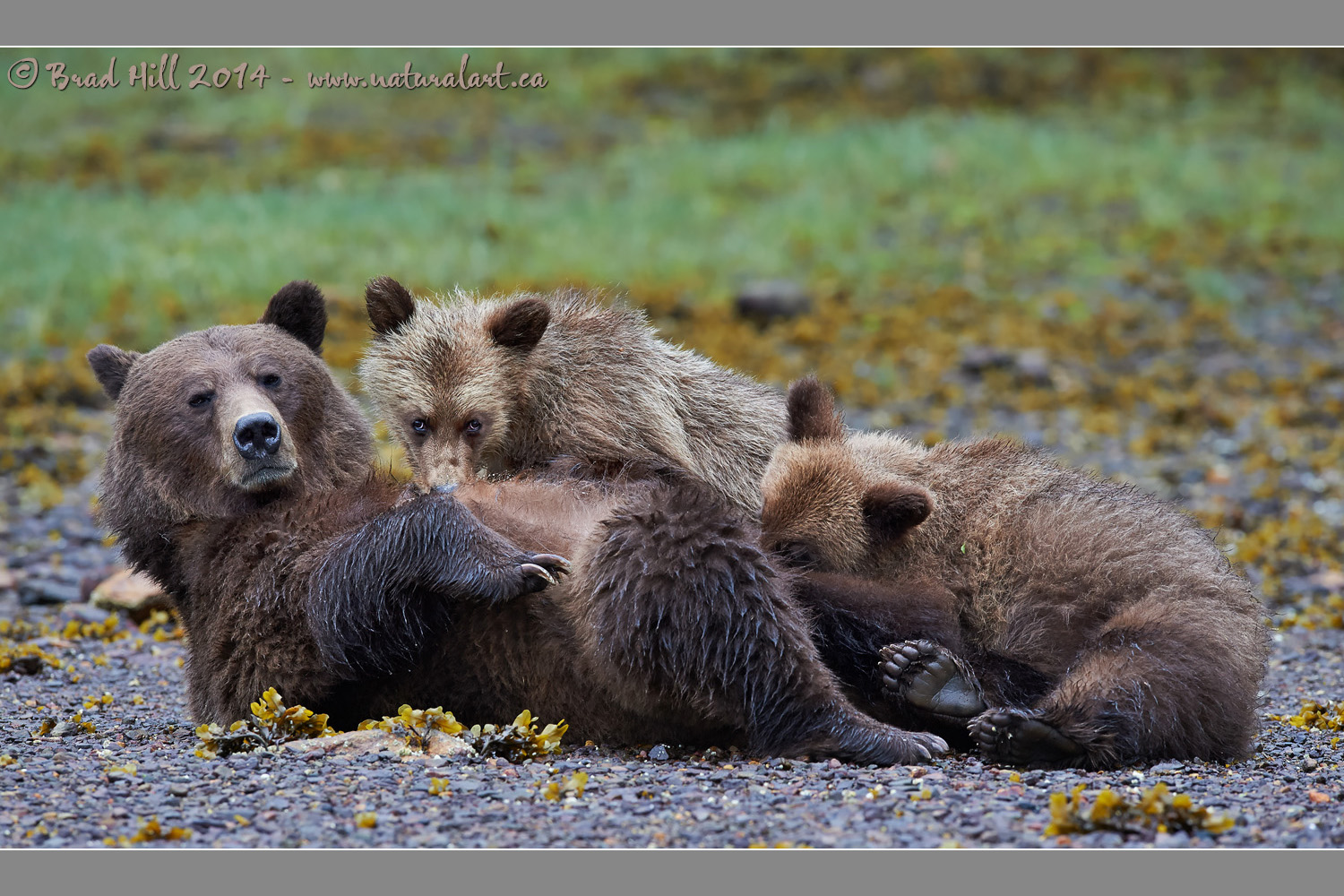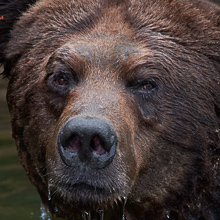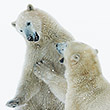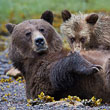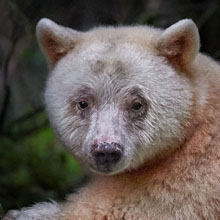Availability: Undetermined - Enquiries?
In the Field
Chowing Down! Khutzeymateen Grizzly Sanctuary, northern BC coast, Canada. May 26, 2014.
Even the most calm and gentle of grizzlies usually like to do SOME things in private. Nursing cubs is normally one of those "in-private only" things - I can't tell you how many times I've watched female grizzlies and their cubs "hang out" in the open for hours, only to disappear into the forest when the cubs needed their milk "fix". So it was a real treat when in the spring of 2014 a female resident of the Khutzeymateen decided we were OK enough to nurse in front of us not just once, but several times (and, fortunately, the participants of each of my Khutzeymateen photo tours got to see it). Ma did keep a close eye on us initially (as shown above), but eventually she focused solely on her cubs and seemed to forget we were floating nearby in a Zodiac.
When nursing the cubs move around from "station-to-station" (i.e., nipple-to-nipple) and in this shot the cubs are working the extreme ends of the array of six nipples that female grizzlies have. These two cubs differed pretty dramatically in personality - the light-faced cub feeding here near mom's head was definitely the bolder and sassier of the two - when feeding on grass it was ALWAYS further from mom than its sibling, and when clamming it persistently pursued mom and tried to steal almost every clam mom dug up (despite occasionally get cuffed by a somewhat frustrated mother). But, despite being bold and adventurous, the light-faced cub kept its eyes on us far more than its shier sibling did. In fact, and as seen in this shot, it was incredibly rare when Mr. White Face didn't have at least one eye on us...
Shooting small groups of animals can be really challenging, especially when using super-telephoto lenses. The first issue often is getting all the animals in your frame doing the right thing (be it looking in the right direction or even just having their heads up simultaneously). And, if you're filling the frame with the group of animals (this image is full frame horizontally) having them all doing the right thing while falling within your zone of sharp focus (or depth of field - DoF) is rare. Of course, you can always stop down the aperture to increase the DoF, but at times this can leave too much in focus and result in poor separation of the subject from the background. When shooting groups of animals I'm always searching for the OPTIMAL aperture and DoF - not the MAXIMUM aperture (and DoF). I want enough DoF to have the key elements in focus (here the three bears and especially the two bear's heads) but the background softly out-of-focus. In a perfect world I would have preferred the foreground to be a little sharper in this shot...but if I had stopped down more to bring it into focus then the background would have got more detailed and "busier" as well. Choosing the optimal aperture and DoF is just one of the many choices (and often compromises and good old problem-solving) that a serious wildlife photographer faces in a field setting and, at least to me, one of the things that keeps it interesting and fresh year in and year out!
Here's a higher resolution (2400 pixel) image for your perusal:
• Chowing Down! Download 2400 pixel image (JPEG: 1.7 MB)
NOTE 1: This image - in all resolutions - is protected by copyright. I'm fine with personal uses of it (including use as desktop backgrounds or screensavers on your own computer), but unauthorized commercial use of the image is prohibited by law. Thanks in advance for respecting my copyright!
NOTE 2: Like all wildlife images on this website, the subject is fully wild and completely unconstrained. Besides the potential impact of my presence, nothing has been done to intentionally alter or affect the ongoing behavior of the subject and, of course, there has been no use of any form of bait or other form of wildlife attractants (including vocalizations).
NOTE 3: This image was captured during one of my "Grizzlies of the Khutzeymateen" photo tour in the spring of 2014. Each year I offer trips into two different parts of the Great Bear Rainforest as well as one to photograph aquatic mammals and oceanscapes near the northern tip of Vancouver Island. And, in selected years, I also offer photo tours to locations to capture other highly sought-after subjects, such as various boreal owl species and wildlife of Canada's Arctic. Details about these trips can be found on the Photo Tours page of this website.
Behind the Camera
Chowing Down! Khutzeymateen Grizzly Sanctuary, northern BC coast, Canada. May 26, 2014.
Digital Capture; Compressed RAW (NEF) 14-bit format; ISO 1400.
Nikon D4s paired with Nikkor AF-S 400mm f2.8 VR - hand-held from floating Zodiac. VR on in Normal mode.
1/500s @ f7.1; -0.33 stop compensation from "recommended" matrix-metered exposure setting.
At the Computer
Chowing Down! Khutzeymateen Grizzly Sanctuary, northern BC coast, Canada. May 26, 2014.
RAW Conversion to 16-bit TIFF, including first-pass/capture sharpening using Phase One's Capture One Pro. Three raw variants (different versions of a single raw capture) processed, differing by a total of 0.7 stops in exposure.
Further digital corrections on resulting 16-bit TIFF files using Adobe's Photoshop CC and Light Crafts LightZone. Photoshop adjustments included compositing (blending) of the three output files from the raw converter, further slight exposure adjustments, selective desaturation of colors, and selective sharpening for web output. Final tweaking of tones performed using LightZone's "tonemapper" tool.
Conservation
Chowing Down! Khutzeymateen Grizzly Sanctuary, northern BC coast, Canada. May 26, 2014.
Ten percent of the revenue generated by this image will be donated to Raincoast*.
Species Status in Canada**: Special Concern (May 2002).
While Grizzly Bears (Ursus arctos) are not technically listed as "Endangered" in Canada, they have been extirpated from most of their historical range. Grizzly Bears are far more sensitive to intrusion/disturbance in their habitat than are Black Bears and are being increasingly forced into marginal habitat by human encroachment. The Great Bear Rainforest along the central and northern coast of British Columbia is one of the last strongholds of the Grizzly Bear in Canada, and even this population is coming under increasing pressure.
On December 18, 2017 the government of British Columbia banned grizzly hunting across the entire province. This major conservation victory came after decades of tireless work by many dedicated conservationists and ecologists and, most importantly, it reflects the opinion of the vast majority of British Columbians. And, it means that AT LEAST while the current government remains in power grizzlies are finally "safe" in British Columbia.
Now that we've at least temporarily won the battle to save grizzlies in BC, it's time to re-focus our efforts toward protecting ALL of BC's carnivores, including Gray Wolves, Black Bears, Cougars, Wolverines, and more! Simply put, there are no ecological, economic, or ethical arguments supporting the trophy hunting of carnivores.
In a great first step towards ending the hunting of carnivores throughout BC the Raincoast Conservation Foundation has developed a program designed to protect ALL carnivores within the Great Bear Rainforest. Details about this program can be found on this page on Raincoast's website. Check it out and, better yet, make a donation to help Raincoast purchase the remaining commercial hunting tenures in the Great Bear!
*The Raincoast Conservation Society (and Foundation) is an effective and efficient organization that has been fighting for protection of this unique habitat. If you are looking for a meaningful way to contribute to the conservation of this amazing ecosystem, Raincoast will provide maximal "bang" for your conservation dollars.
**as determined by COSEWIC: The Committee on the Status of Endangered Wildlife in Canada












